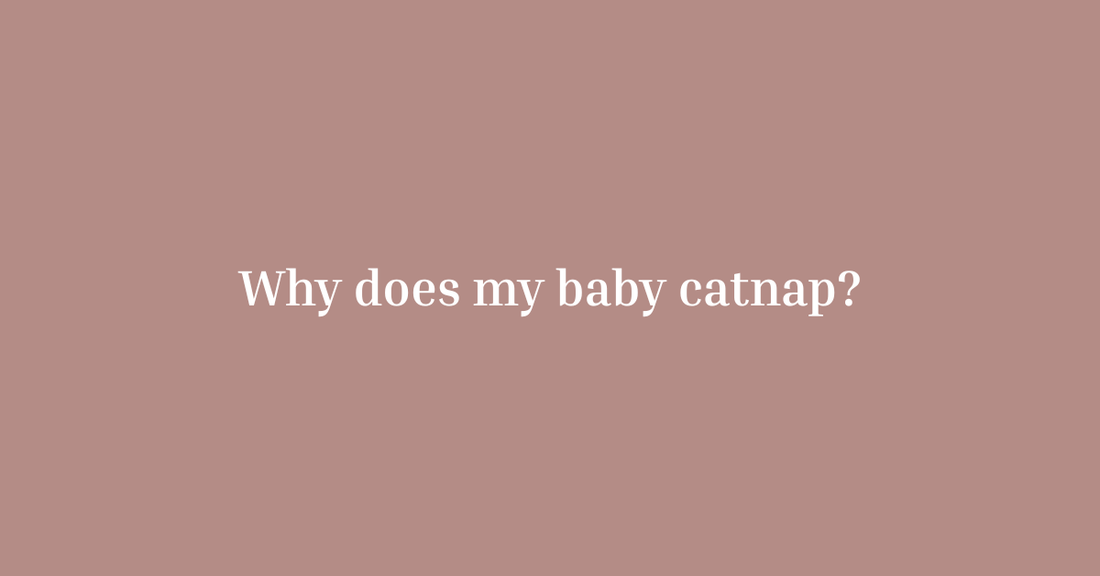
My Baby Only Naps for 30 Minutes. Is That Normal?
Share
The Nap Trap: Why Short Daytime Sleep Is So Common
You feed your baby, rock them to sleep, gently place them down, tiptoe out... and just as you're about to enjoy a hot drink or open a non-baby-related tab, they wake up. Precisely 32 minutes later.
If this happens to you on a near-daily basis, you’re not alone...and you’re not doing anything wrong. In fact, short naps are entirely normal. Here’s what’s going on, and what, if anything, you can do about it.
Babies Have Short Sleep Cycles
While adults sleep in cycles of approximately 90 minutes, babies operate on much shorter sleep cycles; around 30 to 50 minutes, depending on age. Each cycle includes stages of light, deep, and REM sleep. At the end of each cycle, babies naturally stir or even wake completely. Whether or not they fall back asleep depends on several factors.
This is developmentally normal. Most babies under six months old cannot yet link sleep cycles independently, which is why they wake fully after one cycle and need support getting back to sleep.
When Do Naps Typically Get Longer?
There is no universal timeline, but here’s a general idea of how nap patterns tend to evolve:
-
0 to 3 months: Naps are short and irregular. This is completely normal.
-
4 to 6 months: Sleep starts to consolidate. Some babies begin connecting cycles, particularly for morning naps.
-
6 to 9 months: Nap length typically becomes more consistent, with many babies sleeping for 1 to 1.5 hours at a time.
-
9 to 12 months: Longer, predictable naps become more common.
If your baby is nine months old and still only napping for 30 minutes, it might be worth exploring further, but it is not necessarily cause for concern.
Why Babies Wake After One Sleep Cycle
In addition to normal developmental patterns, here are some other factors that can contribute to short naps:
Overtiredness
Babies who stay awake too long produce more cortisol, a stress hormone that makes it harder for them to fall and stay asleep. Ironically, overtired babies often nap more poorly, not better.
Undertiredness
If a baby isn’t quite ready to sleep, they may not settle deeply enough to sleep past the first cycle.
Hunger
Especially for younger babies, hunger can prevent longer, deeper sleep.
Environmental Disruptions
Noise, light, inconsistent routines, or even a sudden temperature change can cause partial arousals to become full wake-ups.
Sleep Associations
If a baby fell asleep being rocked, fed, or held, they might expect the same conditions to continue sleeping. When they stir and those cues are no longer present, they often wake fully.
Is It a Problem?
Not always. Some babies are natural cat-nappers but still get sufficient overall sleep across the day. However, if your baby consistently wakes from naps tired or cranky, and it is affecting night sleep or your household's rhythm, you may want to encourage longer rest periods.
How to Help Your Baby Nap Longer
You cannot force longer naps, but you can gently create the right conditions for your baby to link sleep cycles over time.
Observe Wake Windows
Use age-appropriate wake windows as a guide rather than a rigid schedule. An overtired baby may struggle to fall or stay asleep, while an undertired baby may simply not be ready.
Build a Consistent Nap Routine
Much like a bedtime routine, a nap routine helps cue your baby that sleep is coming. It doesn’t need to be long - five to ten minutes of calm activity can be enough. For example: nappy change, dimming the lights, cuddles, and a short lullaby.
Optimise the Sleep Environment
A calm, consistent space helps babies sleep more deeply. This means:
-
A dark room (blackout curtains can help)
-
A consistent ambient temperature (ideally around 20 to 22°C / 68 to 72°F)
-
Gentle, consistent sound to mask disruptions
Use Sound Strategically
White noise, shushing, and lullabies are more than just relaxing. A well-known 1990 study found that 80 percent of newborns fell asleep within five minutes when exposed to white noise, compared to 25 percent without it (Spencer et al., Archives of Disease in Childhood).
Our own product, Shushiie, is designed around these principles. It allows you to layer white noise, shushing, and lullabies (each with its own dial) and create a familiar audio environment that helps signal sleep. It’s also portable, which helps maintain consistency when you’re away from home.
Try a Mid-Nap Rescue
If your baby wakes after one cycle, try gently resettling them before they are fully alert. A reassuring pat, switching up the sound, or softly humming may help them drift back to sleep.
The Bottom Line
If your baby only naps for 30 minutes, it is almost always a phase, not a flaw. You are not spoiling them. You are not failing to "train" them. You are simply navigating a completely normal part of early development.
Some babies will always be short nappers. Others will gradually begin connecting sleep cycles. With time, consistency, and a bit of patience, most babies will eventually settle into a longer rhythm.
In the meantime, know that a 30-minute nap still counts...every little helps!
